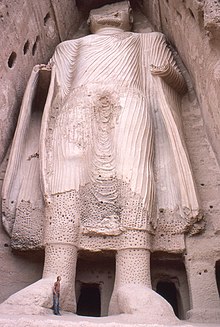
Back আফগানিস্তানত বৌদ্ধ ধৰ্ম Assamese আফগানিস্তানে বৌদ্ধধর্ম Bengali/Bangla Buddhismus in Afghanistan German Βουδισμός στο Αφγανιστάν Greek Budismo en Afganistán Spanish آیین بودایی در افغانستان Persian अफगानिस्तान में बौद्ध धर्म Hindi Buddhizmus Afganisztánban Hungarian Buddhisme di Afganistan ID Storia del buddismo in Afghanistan Italian


Buddhism, a religion founded by Gautama Buddha, first arrived in modern-day Afghanistan through the conquests of Ashoka (r. 268–232 BCE), the third emperor of the Maurya Empire. Among the earliest notable sites of Buddhist influence in the country is a bilingual mountainside inscription in Greek and Aramaic that dates back to 260 BCE and was found on the rocky outcrop of Chil Zena near Kandahar.[1]
Many prominent Buddhist monks were based in Afghanistan during this period: Menander I (r. 165–130 BCE), a Greco-Bactrian king, was a renowned patron of Buddhism and is immortalized in the Milinda Panha, a Pali-language Buddhist text; Mahadharmaraksita, a 2nd-century BCE Indo-Greek monk, is said to have led 30,000 Buddhist monks from "Alasandra, the city of the Yonas" (a colony of Alexander the Great, located approximately 150 kilometres or 93 miles to the north of modern-day Kabul) to Sri Lanka for the dedication of the Mahathupa in Anuradhapura, according to the Mahavamsa (Chap. XXIX);[2] Lokaksema, a 2nd-century Kushan monk, travelled to the Chinese capital city of Luoyang during the reign of the Han dynasty, and was the first translator of Mahayana Buddhist scriptures into the Chinese language.[3]
The Nava Vihara monasteries, located near the ancient city of Balkh in northern Afghanistan, functioned as the centre of Buddhist activity in Central Asia for centuries.
The religion began to decline in Afghanistan after its conquest by Arab Muslims following the rise of Islam in the 7th century CE; it saw further decline in the region during the Muslim Ghaznavid era of the 10th–12th centuries.[4] Buddhism was eliminated in Afghanistan by the 13th century during the Mongol conquests,[5][6] with no further mention of a Buddhist presence in the area past the 14th century.[4]
- ^ Runion, Meredith L. (2007). The history of Afghanistan. Westport: Greenwood Press. ISBN 978-0-313-33798-7.
- ^ Full text of the Mahavamsa Click chapter XXIX Archived 5 September 2006 at the Wayback Machine
- ^ Foltz, Religions of the Silk Road, p. 46
- ^ a b Berzin, Alexander (December 2006). "History of Buddhism in Afghanistan". Archived from the original on 1 November 2016. Retrieved 5 June 2016.
- ^ Cite error: The named reference
:1was invoked but never defined (see the help page). - ^ Cite error: The named reference
:2was invoked but never defined (see the help page).